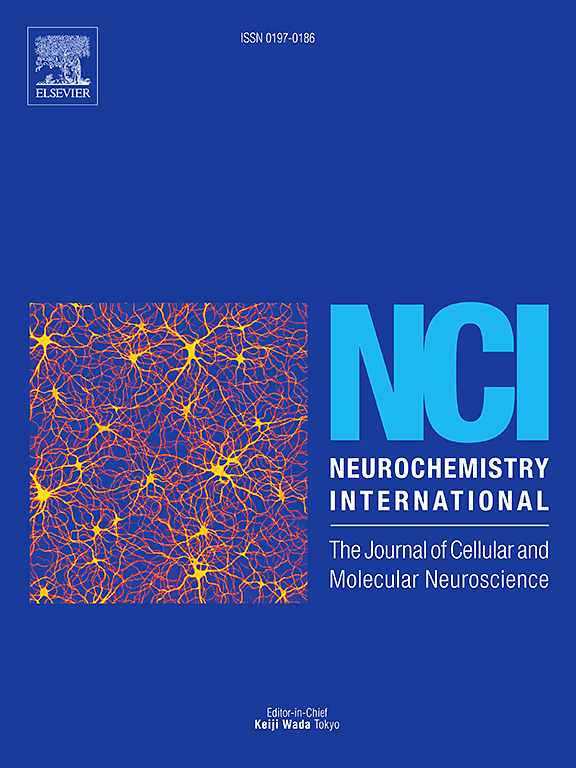Impact of NLRP6 inflammasome on neuroinflammation in temporal lobe epilepsy
IF 4
3区 医学
Q2 BIOCHEMISTRY & MOLECULAR BIOLOGY
引用次数: 0
Abstract
Epilepsy is one of the most common and severe chronic brain diseases, affecting up to 70 million people worldwide. Neuroinflammation plays a central role in the progression of the disease. The Nod-Like Receptor Protein 6 (NLRP6) inflammasome assembles with apoptosis-associated speck-like protein (ASC) to cleave pro-caspase-1 into caspase-1, thus forming the NLRP6 inflammasome. This process promotes the maturation and release of downstream interleukins (IL)-18 and IL-1β, exacerbating pathological processes in various diseases. In this study, we demonstrated significantly enhanced NLRP6 expression in the cortex and hippocampus of epileptic mice, suggesting a role for the inflammasome in epilepsy. Immunofluorescence staining further revealed that NLRP6 was predominantly expressed in hippocampal neurons of these mice. Additionally, knockdown of NLRP6 reduced susceptibility to epilepsy, alleviated post-seizure neuronal damage, and decreased levels of pro-inflammatory cytokines, including IL-18, IL-1β, and IL-6. Conversely, NLRP6 overexpression produced opposite effects, which were effectively reversed by treatment with the caspase-1 inhibitor VX765. To the best of our knowledge, this is the first study to demonstrate a link between NLRP6 and the activation of the caspase-1/IL-1β/IL-18 signaling pathway in a kainic acid (KA)-induced epilepsy mouse model. Administration of VX765 alleviated pathological alterations and exerted neuroprotective effects. These findings suggest that NLRP6 plays a critical role in the initiation and progression of epilepsy.
NLRP6炎性小体对颞叶癫痫神经炎症的影响
癫痫是最常见和最严重的慢性脑部疾病之一,影响全世界多达7000万人。神经炎症在疾病的发展中起着核心作用。nod样受体蛋白6 (NLRP6)炎性小体与凋亡相关斑点样蛋白(ASC)结合,将前caspase-1切割成caspase-1,从而形成NLRP6炎性小体。这一过程促进下游白细胞介素(IL)-18和IL-1β的成熟和释放,加剧了各种疾病的病理过程。在本研究中,我们发现NLRP6在癫痫小鼠的皮层和海马中的表达显著增强,提示炎症小体在癫痫中的作用。免疫荧光染色进一步显示NLRP6在小鼠海马神经元中主要表达。此外,NLRP6的敲低降低了癫痫的易感性,减轻了癫痫后的神经元损伤,降低了促炎细胞因子的水平,包括IL-18、IL-1β和IL-6。相反,NLRP6过表达产生相反的效果,用caspase-1抑制剂VX765治疗可有效逆转。据我们所知,这是第一个在kainic酸(KA)诱导的癫痫小鼠模型中证明NLRP6与caspase-1/IL-1β/IL-18信号通路激活之间存在联系的研究。VX765可减轻病理改变,发挥神经保护作用。这些发现表明NLRP6在癫痫的发生和发展中起着关键作用。
本文章由计算机程序翻译,如有差异,请以英文原文为准。
求助全文
约1分钟内获得全文
求助全文
来源期刊

Neurochemistry international
医学-神经科学
CiteScore
8.40
自引率
2.40%
发文量
128
审稿时长
37 days
期刊介绍:
Neurochemistry International is devoted to the rapid publication of outstanding original articles and timely reviews in neurochemistry. Manuscripts on a broad range of topics will be considered, including molecular and cellular neurochemistry, neuropharmacology and genetic aspects of CNS function, neuroimmunology, metabolism as well as the neurochemistry of neurological and psychiatric disorders of the CNS.
 求助内容:
求助内容: 应助结果提醒方式:
应助结果提醒方式:


